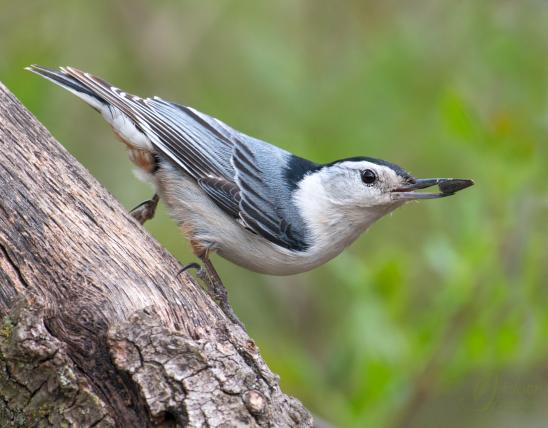
The upperparts of adult tufted titmice are bluish gray. There is a crest on the head, and the forehead is black. Underparts are white, with buff sides and flanks. Song is a whistled “peter-peter-peter” with the first syllables higher. Calls include harsh scolding notes and higher pitched “tseets” and whistles.
Similar species: This is Missouri's only small, mostly gray bird with a definite crest.
Length: 6½ inches.

Statewide.
Habitat and Conservation
Common in trees in forests, woodlands, parks, and suburban areas. This species, with its loud voice, is often the most conspicuous member of winter foraging flocks in forests and woodlands. Although it is a year-round resident in our state, it is most noticeable during winter.
Food
Titmice forage for insects, seeds, and berries, and they are frequent visitors to bird feeders. Many birds gather into mixed-species foraging flocks in the winter months. Forest and woodland birds usually form these flocks in the morning and slowly move through the forest in search of overwintering insects and spiders and their eggcases and cocoons. These flocks often contain titmice, chickadees, nuthatches, woodpeckers, and more. Each species forages in a particular part of a tree or shrub. This allows them to avoid competition with each other.
Status
Common permanent resident.
Life Cycle
A cavity nester that cannot excavate its own holes, the tufted titmouse relies on natural holes, nest boxes, or nest cavities left behind by woodpeckers (many species depend on standing dead trees for nest space). Clutches are usually 3–9 eggs, with one brood a year. Incubation lasts about 2 weeks, and the young fledge about 2 weeks later. When breeding season is over, titmice usually stay together on their territory as a pair, instead of flocking.
Human Connections
In 1904, Neltje Blanchan Doubleday poetically commented, “Titmice always see to it you are not lonely as you walk through the woods.” As common visitors at bird feeders, titmice also bring cheer to snowbound Missourians. On sunny days in late winter, their ringing "peter-peter-peter" is a sign that spring is on the way. Titmice are drab in color, but not in spirit; their effect on people’s moods is real.
If you are wondering about the word "titmouse," it has roots in Old English māse, used in Anglo-Saxon times as the name for closely related birds in Europe. "Tit," the modifier, was used for anything (animal or object) that was small. Over time the spelling of māse was morphed into "mouse," which had became a more familiar word. In Old English, the word for the rodent had been mūs. (Today, the genus name for the common house mouse remains Mus.)
Ecosystem Connections
In Missouri and in other parts of the world, mixed-species winter foraging flocks often organize themselves around a drab-colored species with a loud ringing voice. In Missouri this is the tufted titmouse. This bird’s presence contributes to the success of other species in the flock.
This is the only titmouse in the eastern United States, but there are 4 other species that occur in the southwest, from Texas through California, and north into Idaho and Oregon. Look for them when you go traveling!






Where to See Species
About 350 species of birds are likely to be seen in Missouri, though nearly 400 have been recorded within our borders. Most people know a bird when they see one — it has feathers, wings, and a bill. Birds are warm-blooded, and most species can fly. Many migrate hundreds or thousands of miles. Birds lay hard-shelled eggs (often in a nest), and the parents care for the young. Many communicate with songs and calls.































